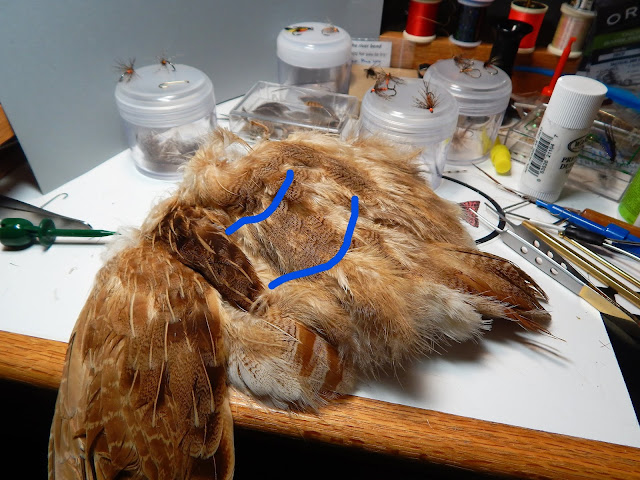For those who love small streams, wild trout, and life...in their simplest form
Thursday, November 21, 2019
"Small And Dark" Explained
In a recent post about going "small and dark" when selecting flies to fish in winter John Dornik made a good comment on how to tie small flies on large hooks. A partridge skin contains a multitude of feathers, some beautiful and some quite ugly. The skin also has feathers of various sizes. The bird is perfect for almost any size fly and a #14 is most prevalent. As you will see in the photos of two skins there are some really outstanding small feathers up on the top of the shoulders and along the backs of the birds.
I have marked the section where these small feathers are located. These are well marked and usually in great shape.
This bird is marked showing the back feathers. Many of these feathers are great for small flies. This skin is bleached and is a favorite of mine.
Here are four hackles taken from the two skins pictured above. They are small and beautifully marked.
A completed soft-hackle fly. Orange silk body, brown squirrel thorax, and partridge hackle.....now this fly is tied on a size 12 hook. The large hook gives better hooking ability as well as it being easier to tie as opposed to tying it on a 16 or 18 hook. The hooks are Firehole 609.
Now that we have the "small" part explained I'm guessing your saying how can an orange body be considered "dark"...silk thread takes on a different shade when waxed or wet...this will be shown in a future post.
Subscribe to:
Post Comments (Atom)






Nice post! Love those soft hackles.
ReplyDeleteMatt Grobert
DeleteThanks
Matt they're fun to tie and awesome to fish.
Informative post Alan and I need all the help I can get!
ReplyDeletebillp
DeleteThanks
Bill I'm going to do a step by step tutorial on a soft-hackle.
I frequently tie a short body on my soft hackles but not to that extent on a size 12. The flies do look great and I will give it a try!
ReplyDeleteNJpatbee
DeleteThanks
Pat I usually bring the thread body to the point of the hook. When I use dubbing I'll bring it back to just about the bend.
A true fly tying artist.
ReplyDeleteMark Kautz
DeleteThanks
I appreciate that buddy.
Wonderful tying and commentary Alan. I love the markings on the unbleached skin. Those gray/barred feathers would be excellent on a Gravel Fly (Partridge & Blue).
ReplyDeleteThanks
Alistair
Anonymous
DeleteThanks
Alistair I purchased that skin on ebay. A great seller of some fine skins. I may give that partridge and blue a try.
Hungarian partridge hackle, a favorite of mine, as well, Alan. Almost impossible to tie a bad fly using it. I'm also very fond of "red" grouse and golden plover, for soft hackles, although these skins are a bit pricey. You really need to buy the entire skin though and not just a packet of feathers. On the other hand I do buy size specific dry fly hackle and not the entire cape.
ReplyDeleteJohn Dornik
DeleteThanks
John Plover is not in my material bucket, but red grouse is and I use it frequently. Loose feathers are junk, my lesson was learned a long time ago. I use Whiting 100 packs for dry flies...uniform and quality.
A great education on fly tying. When tying soft hackles I always feel like I should wrap thread to the bend of the hook. Short of the bend I see will make for a much smaller fly without the need to use such small hooks to accomplish that.
ReplyDeleteSam
DeleteThanks
Sam if you look at Nemes book you'll find that he tied his soft hackles with bodies short, and long. Also in Smith's book it shows the bodies tied to the hook barb. So what I'm saying is there is no set-in-stone way of tying length of bodies, instead it is a matter of choice. You have had success tying soft-hackles so I would continue doing so as you have been. They are great flies.
It is certainly easier to tye a size12 on 6x than trying to do the same with a size 16 hook. Thanks for the tip !
ReplyDeleteResman
DeleteThanks
You are right on about it being easier. As far a tippet size I now use only 5x.
Alan
ReplyDeleteThe four hackles you've selected from the skin shows the options one has when tying a hackle pattern. I imagine there are many more hackle colors that could be taken from that one skin.
The pulsating action of this fly is what keeps me fishing it time after time. Thanks for sharing
Bill Trussell
DeleteThanks
Bill a good partridge skin can offer the tyer so many options. Color and varying shades make for some realistic flies.
I have a really good premium partridge skin I've used for years. I've probably tied over 50 flies with it and it can probably be used for 100's more.
ReplyDeleteFeather Chucker
DeleteThanks
It's a real value purchasing quality partridge skin. The sheer number of great flies more than compensate for the cost.